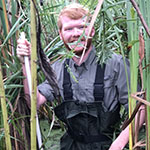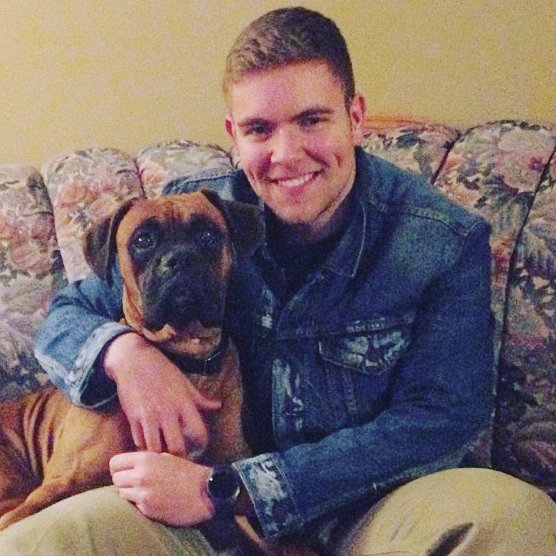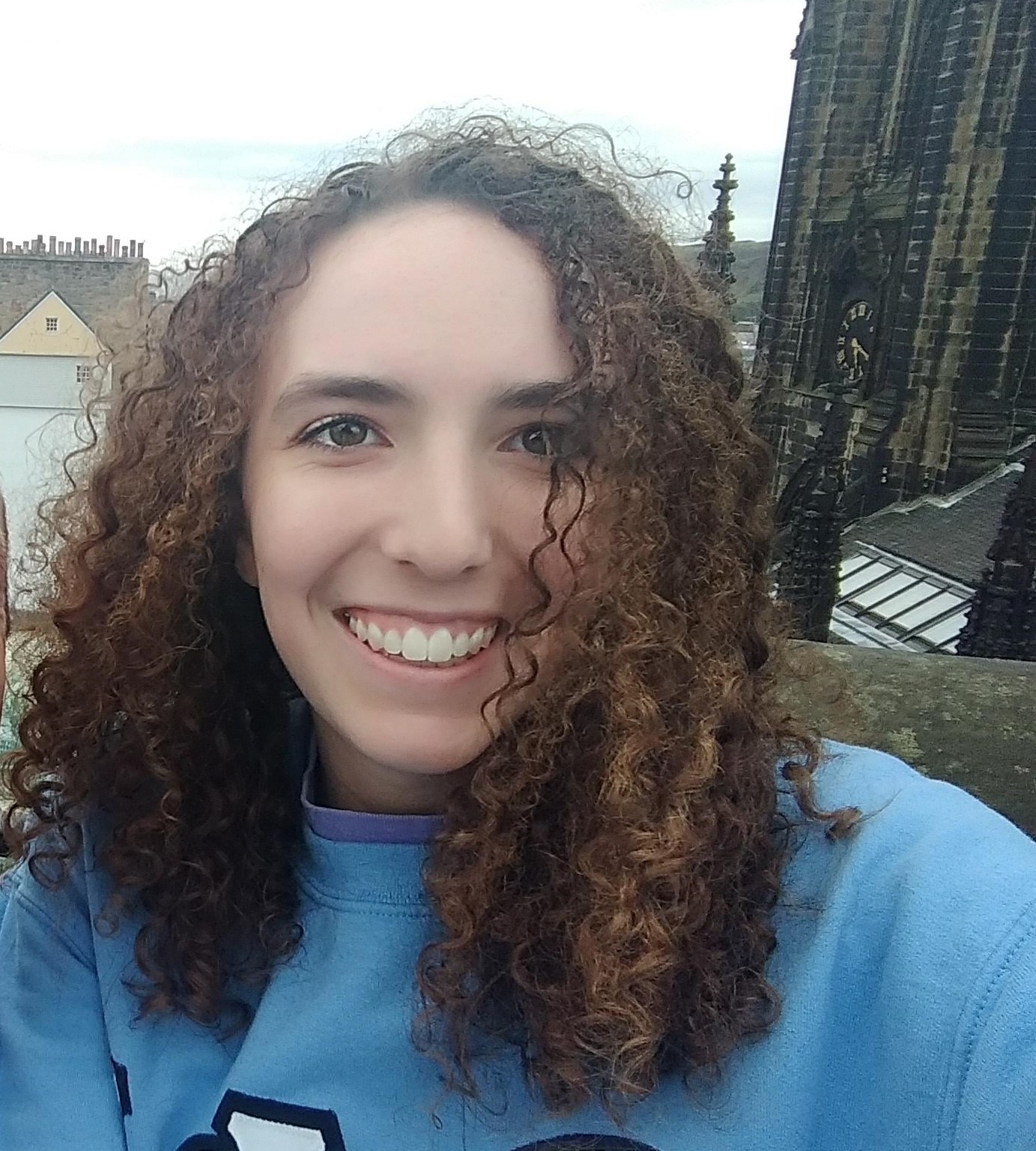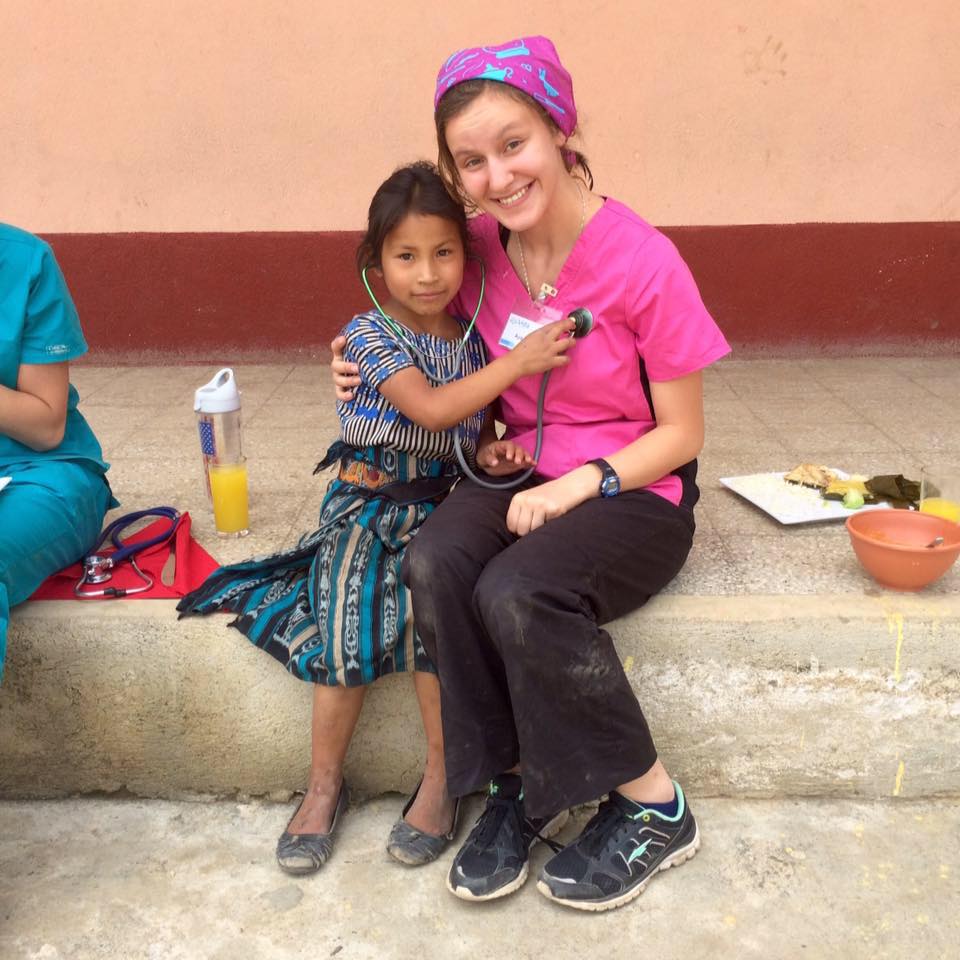Interested in applying to the Ribble Scholarship program?
Click here for eligibility and application information.
Fall 2021/ Spring 2022 Recipients:
Alex Stewart
Research mentor: Dr. Jeremiah Smith
Christine Haddad
Research mentor: Dr. Robin Cooper
- To determine the relationship of external K+ concentration in relation to membrane potential with a varying temperature.
- To determine the mathematical explanation to how the permeability variable will be adjusted in relation to external K+ concentration and temperature in fitting the curves to the Goldman-Hodgkin-Katz equation.
- To determine if calcium activated potassium channels account for the changes in the membrane potential when external Ca2+ concentration is varied.
Fall 2018/Spring 2019 Recipients:
Claire Scott (PI: Jeramiah Smith)
About Me: I am a Biology and Chemistry Dual Degree student with a minor in Flute Performance. In addition to my studies, I am the Vice President of Tri-Beta Biological Honor Society, an Honors College Ambassador, and a member of Alpha Phi Omega Service Fraternity and Phi Delta Epsilon Medical Fraternity. I have always been interested in research, particularly in finding some sort of cure for a disease, but after BIO 198 with Dr. Weisrock and BIO 199 with Dr. Rucker, I found that I am intrigued by epigenetics. Therefore, I began my work in Dr. Smith’s lab working on Programmed Genome Rearrangement (PGR) in lamprey. Lamprey are jawless vertebrates that split from the vertebrate lineage approximately 550 million years ago. By studying PGR, we can help to unearth the mechanisms allowing for this purposeful genome deletion to prevent oncogenesis. I thoroughly enjoy this research and being a part of the Smith Lab and will hopefully continue my work in research as I enter medical school and eventually become a physician.
Project: Programmed Genome Rearrangement in Petromyzon marinus: Studying SUV420H1/2 and SUV39H1
Description: A jawless vertebrate, sea lamprey (Petromyzon marinus), diverged from the vertebrate lineage roughly 550 million years ago, allowing for an evolutionary model to study the mechanism differences of genome alteration including epigenetics in mammals and programmed genome rearrangement (PGR) in lamprey. Through PGR, lamprey delete approximately 20% of their genome of which is retained in germline cells. The mechanisms of PGR have yet to be fully understood; however, the investigation of effect of SUV420H1/2 and SUV39H1 have given some outlook into prospective genes of involvement. SUV420H1/2 transcribes for a methyltransferase that trimethylates Histone 4 at Lysine 20, a site important for recruitment of factors necessary for DNA damage response and therefore DNA repair, an important step in PGR. SUV39H1 transcribes a methyltransferase responsible for catalyzing di- and tri-methylation of Histone 3 at Lysine 9, a significant marker for heterochromatic DNA. Due to its function, it is suspected that PGR levels will decrease in CRISPR-mediated knockouts because the embryos will be lacking a marker for chromatin packaging and deletion. Preliminary results from microscopy demonstrate that the are only small differences between the number of micronuclei per interphase nucleus in CRISPR-mediated knockouts and control embryos. These results portray that similar genes to SUV420 should be investigated.
Madison Von Deylen (PI: Vincent Cassone)

About Me: I am a Biology and Chemistry Dual Degree student with a minor in Gender and Women’s Studies. In addition to my studies, I have been participating in undergraduate research at UK for three years and am involved in several on-campus organizations including Phi Delta Epsilon Medical Fraternity, Alpha Phi Omega Service Fraternity, and the academic honors fraternity of Phi Kappa Phi. I became involved with research during my Freshman year through the STEMCats LLP, through which I have become a mentor, and hope to continue research on human reproductive strategies and behaviors throughout my career.
Project: Female Fertility Perception & Male Coercive Behavior in Humans
Description: Fertility in humans is difficult to detect without testing, but evidence suggests our behavior may fluctuate with its hormonal changes. In these studies, we explore the influence of fertility on three avenues of human reproductive behavior. First, we explore the degree to which women are capable of recognizing their fertility as well as the impact of fertility on sexual motivation and response, conducted through daily journaling and urine analysis. We found no effect of fertility on either, nor did we find evidence that women accurately perceived their fertile window. Third, we explore the impact of fertility on sexually coercive behavior. Sexually coercive behavior increases with female fertility in many primates species, and chances of conception from rape is higher than that of a one-night stand, but there is evidence that women increase coercion-avoidance behaviors when fertile. We studied this relationship through two surveys. The first went to women who rated images of potentially sexually coercive men at different points in their menstrual cycles. The second went to men and included metrics to identify potentially sexually coercive participants as well as images of women who varied in their menstrual status which were rated for potential relationship durations. We found that women do not show a fertility-mediated response to sexually coercive males, but that they do generally find sexually coercive males less appealing than other males. We also found that sexually coercive men do not discriminate between women due to fertility, but are less likely to find any woman appealing for relationship for any length of time.
Fall 2017/Spring 2018 Recipients:
Katherine Breetz (PI: Doug Harrison)

About Me: "My name is Katherine Breetz and I am a Biology major in my junior year. I have always been extremely interested in science classes, but I didn’t reach out to start research until the beginning of my junior year. I have thoroughly enjoyed the opportunity to become more involved in the Biology field through my research and am very thankful I was able to participate. Along with my Biology major, I am working towards a minor in Geography as I am very passionate about traveling. Most recently, I was able to travel to Kenya and go on a medical mission trip, an opportunity I would encourage everyone to try if it presents itself."
Project: The Effects of JAK STAT Knockdowns in the Process of Spermatogenesis in Fruit Flies (Drosophila melanogaster)
Description: Spermatogenesis is the process in which the sperm develops in the male testis. During spermatogenesis, the spermatid begins to grow microtubules that then form the tail of the sperm. Initially, these spermatids are formed in the base of the testis and are considered basal spermatids. As the spermatids develop in a 64-cell cyst formation, they are interconnected, thus able to develop together. Two somatic cyst cells surround the 64-cell cyst formation; these cyst cells receive the signals from the JAK/STAT pathway to begin individualization in the spermatids [1]. These spermatids then individualize, which is a process in which the IC, or individualization complex, breaks down and pushes out the cytoplasm and the interconnecting bridges in a head-to-tail manner through the formation of activation cones [1], which allows separation from other spermatids. As these spermatids then advance down the testis, they become classified as non-basal. At this point, it is known that the JAK/STAT pathway is responsible for spermiogenesis as it send the signal to the somatic cyst cells to initiate individualization, however it is unknown which genes then send the signal to the spermatids [2]. Previous work has determined potential genes in this pathway that may be responsible for the individualization of spermatids, which must be further studied to determine which genes are actually responsible for this process. To determine these potential genes, the JAK/STAT pathway was impaired with the Eye transformer, a negative regulatory short receptor protein [3]. This process was successful in blocking the spermiogenesis before individualization, although it did not alter the maintenance of the stem cells. After the RNA from these testes were removed and RNA sequencing was performed, some of the genes showed an increase in activity while others showed a decrease. These genes were then filtered for functions involving signaling, as research suggests the genes in the JAK/STAT pathways have signaling capabilities, as there must be communication from the cyst cells back to the spermatids to initiate individualization. These prioritized genes were then set aside for further research to limit the number of potential genes of interest. Understanding the JAK/STAT pathway and the genes that play a role in this is important because many different organisms utilize this pathway.
Ben Browning (PI: Dave Weisrock)

About Me: "I am a senior undergraduate student majoring in Biology. I've worked in Dr. Weisrock's lab since my junior year. I got my first hands on lab experience in Dr. Weisrock's BIO 198 class my freshman year. I want to obtain an MS in biology after I graduate from the University of Kentucky."
Project: Species delimitation and species tree reconstruction within the North American tiger salamander complex
Description: The purpose of this project is to better understand the population structure and genetic diversity across populations of the North American tiger salamander (Ambystoma tigrinum) located throughout the United States and Mexico. Next-generation sequencing methods will be performed to collect genetic data on about 400 individual specimens. A range of population genetic and phylogenetic approaches will be used to analyze data. The program STRUCTURE will be used to analyze the data collected to properly identify genetically similar groups of populations and locate species boundaries. The results of these experiments should be the identification of patterns of genetic similarity within and between populations to identify potential species-level lineages, and to reconstruct patterns of common ancestry among major genetic groups. Properly sequenced DNA with few gaps in the data should be capable of creating and refining our understanding the clades of Ambystoma Tigrinum.
Gabrielle Collins (PI: David Westneat)

About Me: "I am a Biology major and I have a minor in history. In addition to being a student, I am also an ROTC Cadet, set to commission as an officer into the United States Army in May 2019. I am also on the Executive Committee for The Campus Kitchens Project, a nonprofit organization aimed at decreasing food waste in Lexington and UK while simultaneously providing sustainable solutions to food insecurity in the Lexington Area. I enjoy travelling, reading, writing, and doing everything I can outside. I have thoroughly enjoyed conducting research in Dr. Westneat’s lab, and getting to use the knowledge I have gained in my Biology classes."
Project: A study of Parental Coordination in House Sparrows
Description: Parental care is a widely-distributed trait that is often vital to the survival of the offspring (Clutton-Brock, 1991). However, caring for offspring is costly, and has been shown to reduce lifespan and decrease future reproductive output (Stearns, 1993). This creates sexual conflict between mates, in which one parent is better off if the other parent does more of the work rearing their offspring. This conflict could be detrimental to offspring, however, if both parents limit their levels of parental care. I have been examining pair coordination, where each parent contributes to raising the offspring by possibly monitoring the behavior of their partner, as a method of mitigating this conflict between mates. An additional complication is that parental coordination may benefit both if it also protects the nestlings from the threat of infanticide. This semester I will be examining factors of parental care across the entire nestling period to gain insight on how metrics of parental care change and to understand factors that influence the level of parental care given. In the field of behavioral ecology, understanding the factors that affect levels of parental care and how those factors contribute to the variance in parental care levels that exists in populations is important in understanding behavior as it influences parental survival and reproduction.
Katie Myers (PI: Jessica Santollo)

About Me: "I am currently a second-year student at the University of Kentucky, with a major in Biology and minors in History and French. I am the Vice President of Programming for UK’s undergraduate chapter of Phi Delta Epsilon (an international medical fraternity) and a peer mentor in the Honors College. I have been heavily interested in research since high school, and I got my first experience doing hands-on lab work in Dr. Weisrock’s BIO 198 class. Since then, I have spent three semesters in Dr. Santollo’s neuroendocrinology lab. I enjoy a little bit of everything in my free time—hiking, reading, listening to music, and watching and playing sports. I am especially interested in neurology and endocrinology and hope to one day become a physician in a research hospital."
Project: Sex Differences in Neurological and Cognitive Performance in Response to 24-hour Water Deprivation in Rattus norvegicus.
Abstract: Studies in humans have shown that the cognitive impairments resulting from dehydration differ between males and females. Although animal models have also shown impaired cognitive function after dehydration, no studies have been conducted in females. Because fluid balance and cognition are both influenced by sex and gonadal hormones, it is plausible that cognitive impairments resulting from dehydration are also influenced by sex. As such, my project tests the hypothesis that cognitive impairments resulting from 24 hour water restriction differ between males and female rats. In order to test this hypothesis, I will be using the object recognition (NOR) test, which assesses an animal’s cognitive ability according to its memory of previously seen objects. Following the 24 hour water deprivation treatment, brain function will be further characterized in males and females by quantifying the number of Fos-positive cells (a measurement of neuronal activity) in areas of the brain involved in learning and memory. Our preliminary data suggests that, as predicted, the memory impairments following dehydration are different between males and females.
Josie Llanora (PI: Julie Pendergast)

About Me: I am a junior, majoring in Biology and with a minor in Neuroscience. I currently serve as the Public Relations Chair of DanceBlue, the University of Kentucky’s 24-hour, no sitting, no sleeping dance marathon that benefits pediatric cancer treatment. I hope to attend medical school and continue my research experience in a field of pediatrics. I’m also interested in health and fitness, so I enjoy going to the gym or for a run.
Project: The Effects of Maternal Obesity on Circadian Rhythms in Offspring
Abstract: About 20% of women are obese during pregnancy. These obese mothers may transmit obesogenic traits through generations. Children born to obese mothers are at increased risk of obesity, impaired glucose tolerance, and other facets of metabolic syndrome. Circadian rhythms are 24-hour daily rhythms in physiology and behavior, such as the sleep-wake cycle. Disruption of circadian rhythms is associated with arrhythmic eating behaviors and weight gain, leading to an overall decrease in health. In male mice, high fat diet (HFD) alters circadian rhythms and increases body weight. However, female mice fed HFD do not become obese, and their circadian rhythms are not altered. This project will test the hypothesis that female offspring weaned from a maternal high fat diet will display disrupted eating behavior rhythms. Female C57BL/6J PERIOD2::LUCIFERASE mice are fed HFD prior to pregnancy, during pregnancy, and during nursing. After weaning, female offspring are fed HFD. I measure locomotor activity with infrared sensors and eating behavior with infrared cameras. So far, my results show that females born to obese mothers have arrhythmic or low-amplitude eating behavior rhythms compared to females born to lean mothers. These results suggest that maternal HFD consumption may alter eating behavior rhythms in offspring.
Fall 2016/ Spring 2017 Recipients:
Trae Brooks (PI: Bruce O'Hara)

About Me: "I have had a passion for the sciences since middle school, but it wasn't until my junior year in college that I took the opportunity to participate in undergraduate research. It has been truly invaluable to my undergraduate experience here at the University of Kentucky, and my only regret is that I didn't start doing research sooner. In addition, being able to actually apply the knowledge that I have learned in the classroom over the years and contribute to the larger body of science through my research is a truly rewarding feeling, and has solidified my choice to pursue medicine as a professional career. I have several hobbies that I enjoy when I have free time away from my studies, which include weightlifting, hanging out with friends, playing computer games, and spending time with my family."
Project: A Comparative Study of Circadian Rhythms and Sleep between House Mouse (Mus musculus) and African Spiny Mouse (Acomys cahirinus) in Single and Group Housing Conditions
Abstract: The study of circadian and sleep behavior of different organisms can provide invaluable insight towards understanding the behavioral, physiological, and environmental influences on these processes. Two species of African spiny mice, Acomys cahirinus (Cairo spiny mouse) and Acomys russatus (Golden spiny mouse) demonstrate differing patterns of circadian rhythm in areas where their habitats overlap. Few studies are available that detail the circadian rhythms of these two species. For that reason, we have begun to investigate one of these species (A. cahirinus) alongside the well-studied house mouse (Mus musculus). Our results show that both A. cahirinus and M. musculus are predominantly nocturnal, but also demonstrate unique behavioral patterns. Using IR cameras in conjunction with electroencephalogram (EEG) recordings, we were able to determine the approximate sleeping patterns of A. cahirinus experimentally.
Eashwar Somasundaram (PI: Robin Cooper)

About Me: : “My name is Eashwar Somasundaram. I am currently a sophomore at the University of Kentucky. I am a reader, so you will always find me with a book or an article. My career goal is to be a physician-scientist, a doctor who both practices and researches medicine.”
Project: Modulatory Action of Acetylcholine in mechanosensory processing in Drosophilia melanogaster: behavior, development, and sensory-motor circuit physiology.
Abstract: Acetylcholine is a neurotransmitter necessary for detecting mechanosensory stimuli in Drosophilia. This project seeks to characterize class IV cholinergic neurons (ppk neurons). Class IV neurons are required in detecting noxious or painful stimuli. We are interested in how these neurons affect behavior, motor output, and development of the nervous system. Using a GAL4/UAS system, we can stimulate or inhibit class IV neurons in Drosophilia larvae with heat or light. We can observe behaviors such as body wall contraction and stereotyped noxious stimuli behaviors (defensive behaviors against pain such as rolling). Using electrophysiology, we can measure EPSPs in muscle fibers using an electrode while we stimulate or inhibit the ppk neurons with light. We can also image ppk neurons using a confocal microscope to visualize the structure. We will also stimulate or inhibit ppk neurons throughout development of the larvae. We are interested in finding any differences in the behavior, muscle response, or structure of the neurons. We have concluded so far that stimulating or inhibiting ppk neurons does not affect movement, but it does stimulate or inhibit nociceptive response respectively. Stimulating ppk neurons through development generally decreases the locomotion of larvae. Our next goal is to image the neurons of larvae with stimulation of ppk neurons through development.
Brennan Pike (PI: Nicholas McLetchie)

About Me: "I am a Biology major with an Economics minor. I plan on getting my Masters in Public Health then attending medical school to become a physician, using my degree to focus on prevention along with treatment of health problems and illnesses. I am a Resident Advisor on campus along with being in Phi Delta Epsilon and the National Residence Hall Honorary. I enjoy being active and going on hikes, taking on new adventures, or just reading and reading a book."
Project: Habitat specific acclimation to dehydration in the tropical liverwort Marchantia inflexa
Abstract: This project is to discover if there is any sex ratio bios in dioecious plants. The specimen being studied is a species of tropical tropical liverwort, Marchantia inflexa. This plant is dioecious, having both male and females, which in some way can present some issues for reproduction as plants in areas with high numbers of one gender cannot generally relocate to be in a population more homogenous. What causes biased sex ratios is still an unknown factor. A factor that may affect this dehydration tolerance which is an adaptation which enables tissue to survive a substantial amount of drying. We hypothesize that since it is known M. inflexa females have an increased stress tolerance, they will be more abundant in more drought prone habitats than moist habitats. A large problem in the world is drought and in upcoming years, these incidents are predicted to increase. Plants which are dehydration tolerant are highly effective for weathering unfavorable conditions and thus by studying these plants a discovery may be found to benefit crop species and minimize crop loss.
LaShay Byrd (PI: Robin Cooper)
About Me: "I am a Biology major with a minor in Appalachian Studies. I hope to attend medical school and pursue a career as a Family Medicine physician with an emphasis on rural and community health. In my spare time I enjoy reading and watching classic television shows."
Project: Attempting to improve the health of rural Kentucky citizens through educating its youth with health integrated school work and online mentoring interactions
Abstract: Kentucky consistently ranks among the top ten states nation-wide for the highest rates of chronic, preventable diseases. High school graduates in Kentucky are only required to successfully complete one semester of health, of which the course-work is didactic and rarely transformative. The adoption of the Next Generation Science Standards, which advocate deep understanding and application of content, and using science to make informed decisions, provides a natural opportunity to integrate the National Health Education Standards into required science classes. We are developing an educational unit around the topic of Metabolic Syndrome (MSy). We capitalize on the knowledge of the life cycle, physiology, genetics, and behavior of Drosophila melanogaster to investigate the effects of diet on development, survival, behavior, environmental stress on survival and behavior, as well as physiological functions such as heart rate and neural-muscular function with sensory motor tasks. We have started with high school classes defining the disease of MSy and contributing factors. High school classes are now designing live models of fruit flies fed different diets and examining the health (behavior, heart function, development and survival) of the fly populations. Students are developing talking points based on what they have personally learned, design displays, and use their models to teach others. For a culminating event, students will set up their demonstrations and displays, much like they do for a school science fair/symposium, in the places where rural people congregate the most - parent teacher conference night, churches, ball games, flea markets.
Spring 2016/ Fall 2016 Recipients:
Aya Omar (PI: Robin Cooper)
About Me: "I am an Animal Science and Biology double major with a Spanish minor. I plan on attending Veterinary School after graduation and pursing a career in Global medicine. I serve as the Vice President of Leadership for Alpha Phi Omega and work as a Veterinary Assist at Bluegrass Veterinary Specialists plus Animal Emergency. In my spare time I love writing music and playing a variety of instruments. I also enjoy reading, horseback riding and bringing back outdated phrases from the 70s."
Project: Pharmacological identification of cholinergic receptor subtypes in modulation of Drosophila melanogaster sensory-motor circuits.
Abstract: We are currently finishing up this project in which the main goal has been characterizing the cholinergic system through modulation of the ionotropic nicotinic acetylcholine receptors (nAChRs) and the metabotropic muscarinic acetylcholine receptors (mAChRs). We are using a pharmacological approach in which larval Drosophila behaviors/responses are documented after exposure to various agonists and antagonists for the aforementioned receptors over various spans of time. After the completion of this project, we will return our focus to the activation of sensory neurons with optogenetics in larval Drosophila to determine if particular times during stimulation will show long term effects in behavior and physiological changes in the neural circuits.



